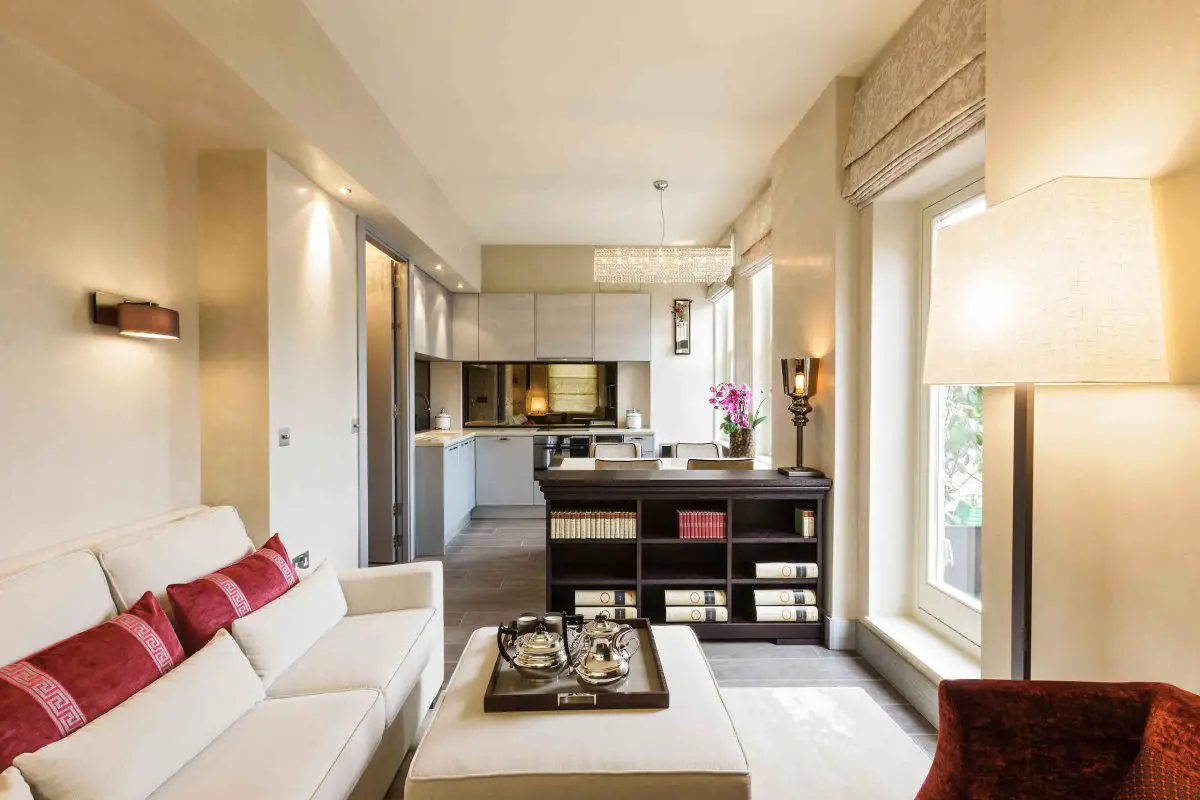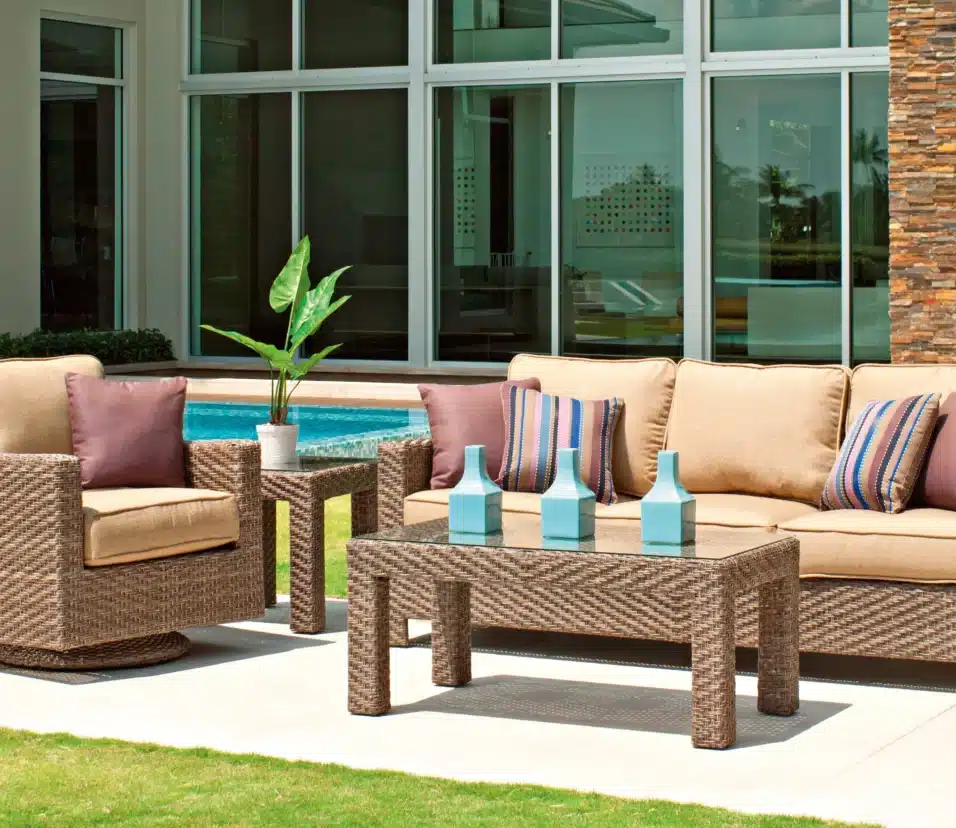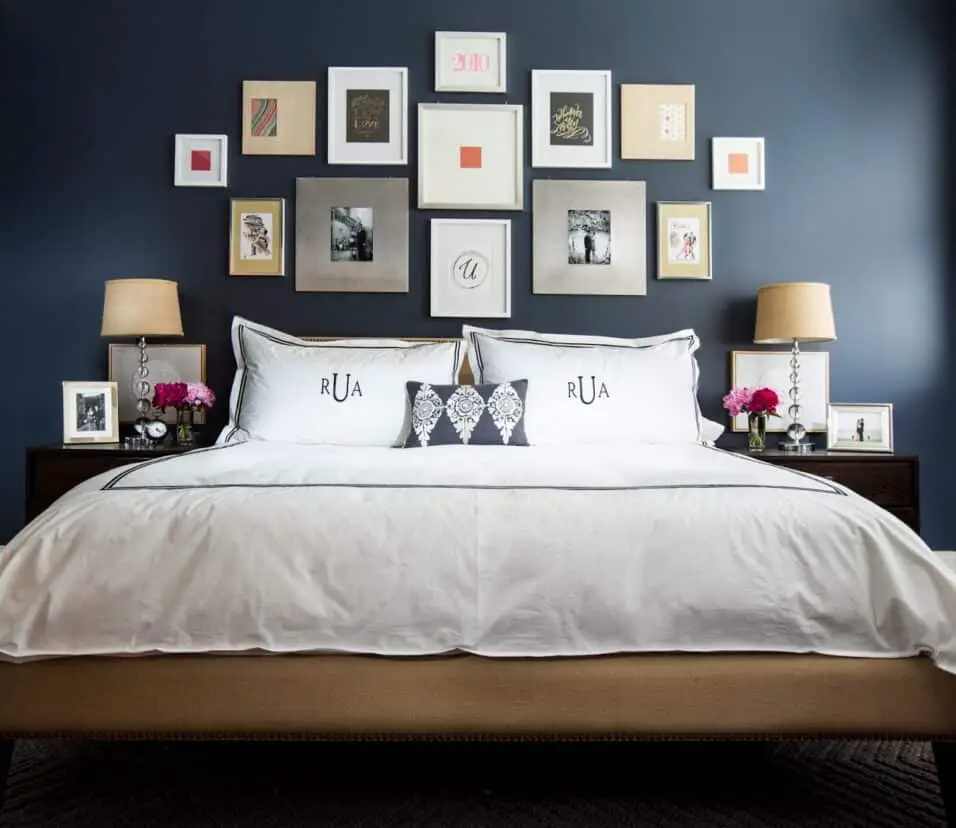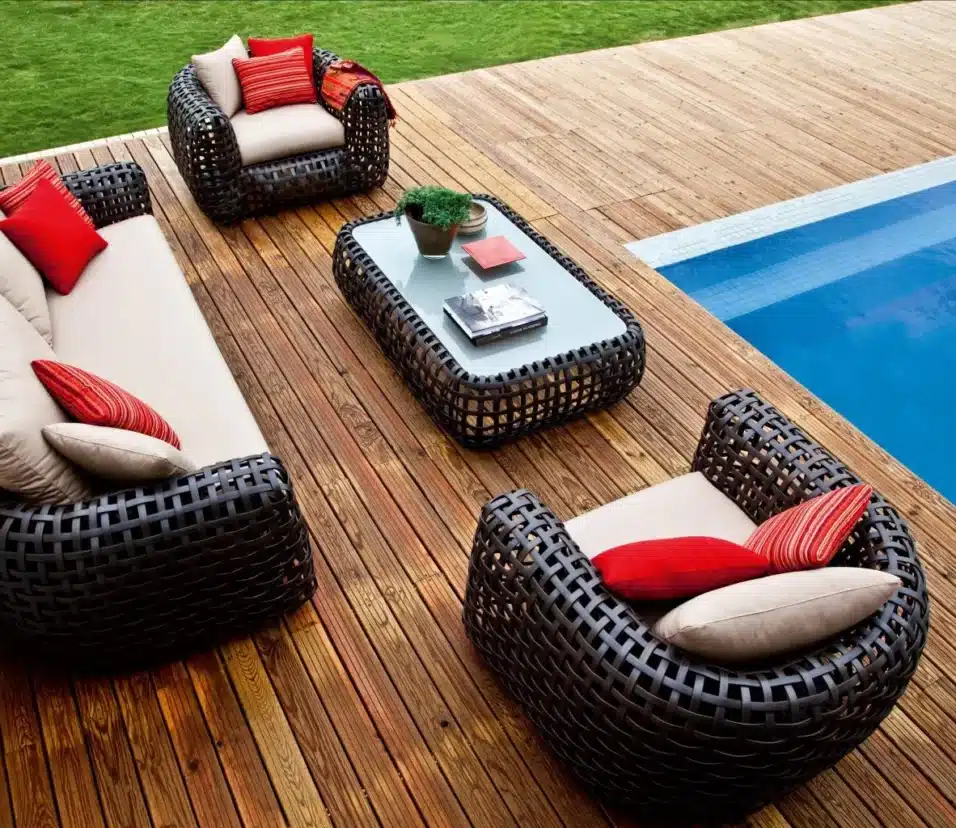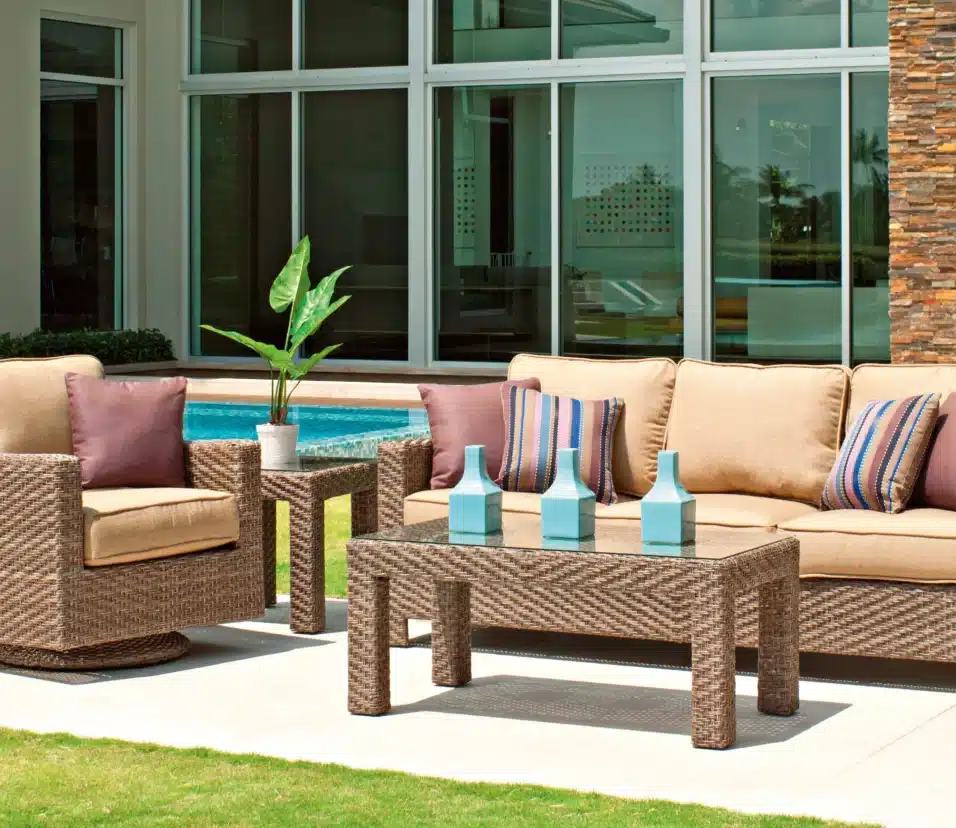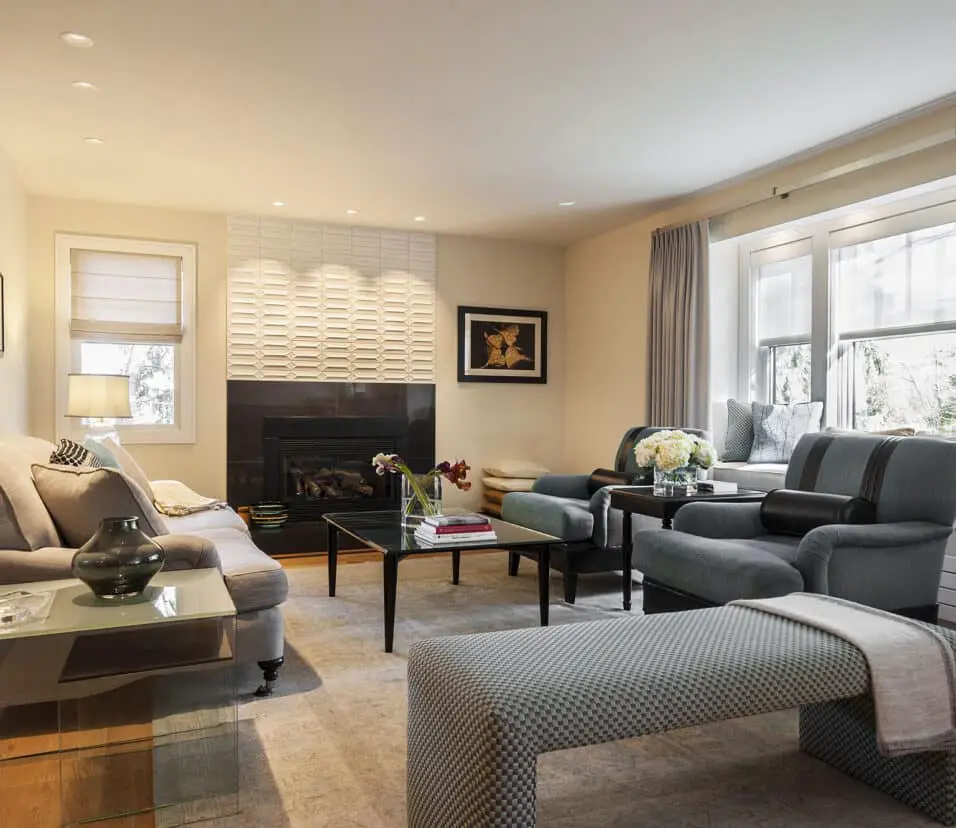How To Arrange Furniture In Studio Apartment
Introduction
How To Arrange Furniture In Studio Apartment: One of the key principles of arranging furniture in a studio apartment is to embrace a minimalist approach. By carefully curating your belongings and choosing furniture pieces that serve multiple purposes, you’ll create an open and airy feel, making your studio appear more spacious. Multi-functional furniture is your best friend in a studio apartment. Consider investing in a sofa bed or a daybed that can double as seating during the day and transform into a comfortable sleeping area at night. Opt for coffee tables with hidden storage or ottomans that open up to reveal extra space for blankets, books, or other essentials.
Next, let’s explore the power of vertical space. Utilize wall shelves, floating cabinets, and bookcases to keep the floor area clutter-free while providing ample storage for books, decor, and personal belongings. Hanging plants or wall art can also add a touch of personality to your studio without taking up precious floor space. Creating distinct zones within your studio apartment can help define different areas for various activities. Use area rugs, room dividers, or even strategically placed furniture to separate your sleeping area from the living space, or designate a corner for a home office or arrange furniture study nook.
Lighting plays a crucial role in enhancing the ambiance of your studio apartment. Consider incorporating floor lamps, wall sconces, or string lights to add warmth and a cozy atmosphere to your living space. Additionally, mirrors can do wonders in making a small space feel larger by reflecting light and creating an illusion of depth. Finally, don’t underestimate the impact of colors and decor. Choose a cohesive color scheme that visually connects different areas of your studio and makes the space feel harmonious. Incorporate personal touches with artwork, cushions, or decorative pieces to infuse your unique style into the overall design.
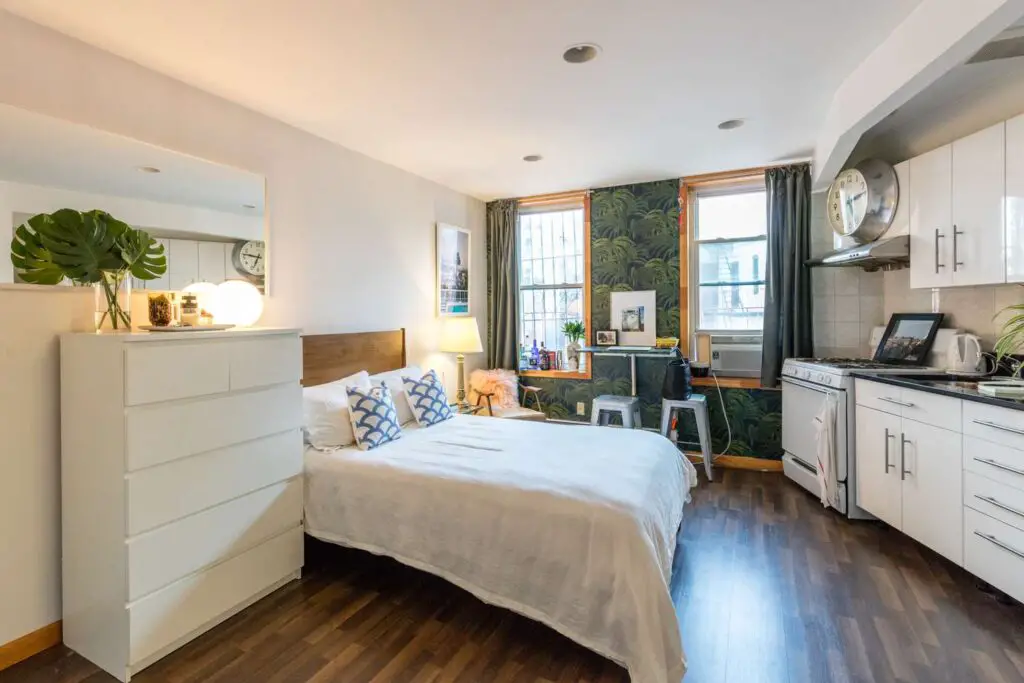
How do you organize a studio apartment?
- Create Storage Underneath Your Bed and Sofa.
- Shop for Furniture That Doubles as Storage.
- Or, Choose Convertible Furniture.
- Divide and Conquer With Multi-Tasking Room Dividers.
- Try Vertical Bookshelves.
- Upgrade Your Storage Box Situation.
- Reclaim Floor Space With Floating Shelves.
- Arrange Clothing and Accessories as Wall Decor.
Declutter and Purge: Before diving into the organizing process, decluttering is essential. Go through your belongings and determine what you truly need and love. Donate or sell items that you no longer use, and keep only the essentials. A clutter-free space will instantly make your studio apartment feel more spacious and organized.
Define Zones: In a studio apartment, creating distinct zones for different activities is key to maintaining a sense of organization. Think about how you will use the space and designate areas for sleeping, living, dining, and working. Use area rugs, furniture placement, or room dividers to visually separate these zones while maintaining an open and cohesive feel.
Invest in Multi-Functional Furniture: Maximizing the functionality of your furniture is crucial in a small space. Look for pieces that serve multiple purposes, such as a sofa bed, a dining table that doubles as a workspace, or ottomans with hidden storage. This way, you can make the most of your furniture while saving valuable space.
Utilize Vertical Space: When floor space is limited, don’t forget about the potential of your walls. Install floating shelves, wall-mounted cabinets, and hooks to store items and display decor. Vertical storage not only keeps your belongings organized but also draws the eye upward, creating the illusion of a higher ceiling.
Maximize Storage Solutions: Explore creative storage solutions to keep your belongings tidy and easily accessible. Use under-bed storage containers, stackable bins, and drawer organizers to make the most of every nook and cranny. Consider installing a closet organizing system to optimize your wardrobe space.
How to choose furniture for studio apartment?
This Is How to Choose the Best Furniture for Your Small Space, Designers Say
- Don’t Overcrowd the Room.
- Make Sure Every Piece Serves a Purpose (or Two or Three)
- Keep Furniture Simple and Functional to Leave Room for Decor.
- Pay Attention to Proportions.
Measure Your Space: Start by measuring the dimensions of your studio apartment, including the length, width, and height. This will give you a clear idea of the available space and help you choose furniture that fits perfectly without overwhelming the room.
Prioritize Multi-Functional Pieces: In a studio apartment, multi-functional furniture is your best friend. Look for items that serve more than one purpose, such as a sofa bed, storage ottomans, or a dining table that can double as a workspace. These pieces will save valuable space and enhance the functionality of your living area.
Consider Scale and Proportions: Opt for furniture that complements the size of your studio apartment. Choose pieces that are neither too large nor too small for the space. Oversized furniture can make the studio feel cramped, while tiny pieces may make it appear sparse. Strike a balance between comfort and space optimization.
Choose Light and Airy Designs: Furniture with an open and airy design can make your studio apartment feel more spacious. Opt for pieces with legs or open bottoms that allow light to pass through, creating a sense of openness. Avoid heavy, solid furniture that can visually weigh down the room.
Maximize Storage: Storage is crucial in a studio apartment. Look for furniture with built-in storage solutions, such as drawers in bed frames or shelves in coffee tables. Utilize vertical space with tall bookshelves or cabinets to keep your belongings organized and out of sight.
How do you manage a small studio apartment?
Tips & Tricks for Maximizing Space in a Studio Apartment
- Eliminate Clutter. Photo via @karrrrst.
- Define the Space.
- Try Minimalist Design.
- Keep Furniture Against the Wall.
- Opt for Semi-Open Furniture.
- Use Mirrors in Your Small Apartment.
- Limit Your Statement Pieces.
- Get More Space with Multiple Levels.
Vertical Storage: Utilize vertical space to its fullest potential. Install shelves, hooks, and wall-mounted organizers to keep items off the floor and create additional storage areas for books, decor, and everyday essentials.
Under-Bed Storage: Make use of the space under your bed by investing in bed frames with built-in storage or using under-bed storage containers. This area is perfect for storing seasonal clothing, extra bedding, or other items you don’t need daily access to.
Maximize Closet Space: If your studio apartment has a closet, install a closet organizing system to make the most of the available space. Use hangers, shelves, and organizers to keep your clothes and accessories tidy and easily accessible.
Use Room Dividers: Room dividers can create the illusion of separate spaces within a studio apartment. They can help define distinct zones for sleeping, living, and dining, providing a sense of privacy and organization.
Keep It Light and Bright: Use light colors for walls, furniture, and decor to make your small space feel more open and airy. Maximize natural light by using sheer curtains and keeping windows unobstructed.
Mirrors for Depth: Strategically place mirrors to reflect light and create the illusion of a larger space. Mirrors not only add visual depth but also brighten up your studio apartment.
What size bed is best for a studio apartment?
When it comes to beds for studio apartments, you’ll want to stick to a full or smaller, most likely. You might be able to get away with a queen, but my guess is that you’ll be trading a practical amount of living space for a slightly larger bed, and it might not be worth it.
Keep in mind that you will likely have other furniture pieces in your studio apartment, such as a sofa, dining table, or desk. Ensure that there is enough space for both the bed and other essential furniture without creating a cramped or cluttered environment.
While maximizing space is essential, don’t compromise on your comfort and quality of sleep. Choose a bed size that allows you to sleep comfortably, ensuring you have enough space to stretch out and move freely during the night.
If you’re living alone and have limited space, a single or twin bed might be the most suitable option. A single bed is around 38 inches wide and is ideal for a single person. If you have a bit more space, a double bed (also known as a full bed) with a width of around 54 inches can accommodate a single person more comfortably or provide a cozy sleeping space for a couple.
For maximum space efficiency in a studio apartment, consider a sofa bed. A sofa bed combines seating and sleeping functionalities in one piece of furniture, allowing you to use your living area more flexibly and saving space that would otherwise be taken up by a separate bed.
If you have a larger studio apartment and sufficient space in the bedroom area, you might consider a queen or king-size bed. A queen bed is around 60 inches wide, offering more sleeping space for single sleepers or couples. A king bed is even larger at approximately 76 inches wide, providing the most luxurious sleeping space but requires more room.
How to make studio apartment feel like 1 bedroom?
You can divide up space in a studio apartment using freestanding room dividers such as wood or fabric screens, open bookshelves, temporary walls, or floor-to-ceiling curtains. Another way to create different zones in a single space is to use transforming furniture such as a Murphy bed.
Invest in room dividers or folding screens to visually separate different areas of your studio apartment. Place a room divider between the sleeping area and the living space to create the illusion of a separate bedroom.
Position your bed in a designated nook or corner to create a cozy sleeping area. Use a curtain or hanging fabric to partially enclose the nook, adding a touch of privacy and intimacy.
Place tall bookshelves or freestanding cabinets strategically to create a boundary between the bedroom and living areas. These units not only offer additional storage but also act as visual barriers to define separate zones.
Choose a daybed or a sofa bed for your seating area that can double as a sleeping space when needed. This versatile furniture piece allows you to transform the living area into a bedroom at night.
Consider installing a Murphy bed, also known as a wall bed, which can be folded up against the wall when not in use. This clever space-saving solution allows you to have a dedicated sleeping area that can be hidden during the day.
Hang curtains or fabric panels to visually divide the studio apartment into different areas. You can draw the curtains when you want more privacy in the sleeping area, and keep them open to create an open-concept living space.
What do you sleep in in a studio apartment?
Typically, you’ll need to purchase a Murphy bed kit, which you can do at many furniture stores, big box home stores or online through a wall bed company. They range in price, depending on whether you want a more elaborate wall unit storage system or a smaller, single fold-up bed system.
The most traditional option is a regular bed, such as a twin, full (double), queen, or king-size bed. The choice of bed size depends on the available space in your studio and your personal comfort requirements. A regular bed provides a dedicated sleeping area and can be complemented with a headboard for added style.
A daybed is a versatile option that serves as both seating and a bed. It typically resembles a couch during the day and can be used for lounging or as extra seating. At night, it can be easily transformed into a comfortable sleeping surface, making it an ideal solution for studio apartments with limited space.
A sofa bed combines the functionalities of a sofa and a bed. It provides seating during the day and can be folded out into a bed at night. Sofa beds come in various sizes and styles, offering a comfortable sleeping option while saving space during the daytime.
A futon is a Japanese-style mattress that can be folded and used as a seating surface during the day. It can be unfolded to serve as a bed at night. Futons are compact and can be easily stored away when not in use, making them an excellent choice for studio apartments.
A Murphy bed, also known as a wall bed, is a space-saving option that can be folded up against the wall when not in use. It provides a dedicated sleeping area that can be hidden during the day, freeing up valuable floor space.
What is too small for a studio apartment?
Studios could be as small as 300 square feet to 1,000, depending on the location. Rent Cafe put together this helpful chart of average apartment sizes in the U.S., with everything but 2 bedrooms showing a downtick in size based on when the apartment was built.
A studio apartment without adequate storage space can quickly become overwhelmed by clutter. If there is no space to store essential items, it can lead to a disorganized and chaotic living environment.
While studio apartments have an open-concept design, a complete lack of separation between the sleeping, living, and kitchen areas can make it feel cramped and congested. Having no distinction between spaces may also lead to privacy and functionality issues.
Insufficient natural light can make a small studio apartment feel even smaller and darker. Lack of sunlight can affect the overall ambiance and mood of the space.
If the layout of the studio apartment offers no privacy for the sleeping area or bathroom, it may not be suitable for comfortable living. Having a private space to retreat to is essential for a well-rounded living experience.
A studio apartment may be too small if there is no feasible way to arrange furniture to create a functional and visually appealing living space.
If there is no space for essential appliances like a refrigerator, stove, or microwave, it can severely limit your ability to cook and maintain a comfortable lifestyle.
Is it hard living in a studio apartment?
For young people living on their own for the first time, studio apartments are ideal because of their affordability. However, it’s definitely challenging cramming everything into 300 square feet. As long as you remember to be creative and stay organized, you’ll figure out how to live in a studio apartment in no time.
Lack of Privacy: The absence of separate rooms means limited privacy, especially for activities like sleeping, studying, or working.
Noise and Disturbances: Noise from various activities can be more noticeable in a small space, affecting the overall tranquility.
Storage Constraints: Limited storage space can make it challenging to keep belongings organized and accessible, potentially leading to a cluttered environment.
Feeling Constrained: Some individuals may feel confined in a small space, especially if they enjoy larger living areas or outdoor activities.
Balancing Aesthetics and Functionality: Furnishing and decorating a studio apartment can be tricky, as residents must strike a balance between aesthetics and functionality.
Limited Hosting: Hosting guests can be challenging in a small space, as there may not be enough seating or sleeping arrangements for visitors.
Cost-Effective: Studio apartments generally have lower rent and utility costs compared to larger apartments or houses, making them an attractive option for budget-conscious individuals.
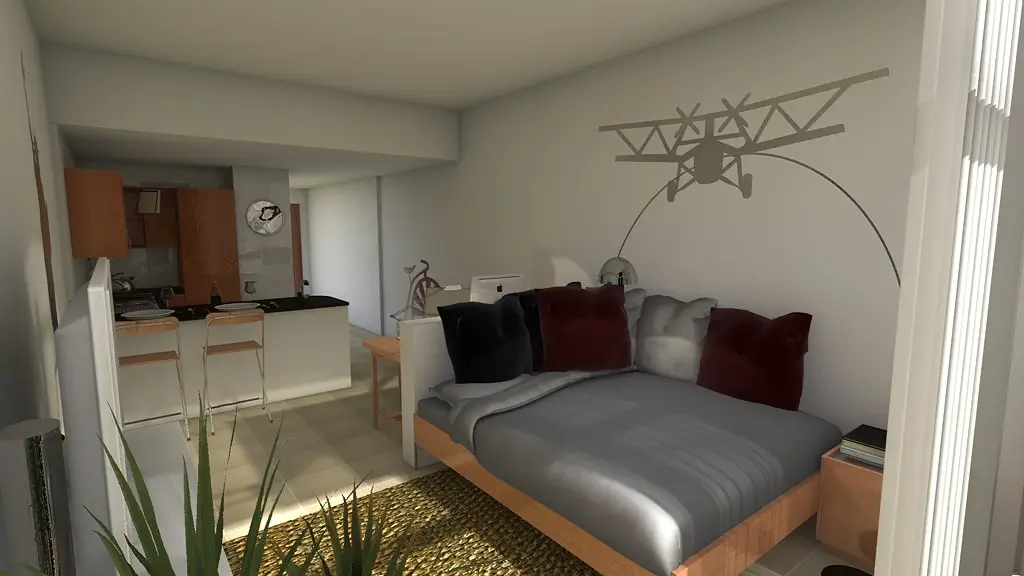
Conclusion
By carefully selecting versatile furniture pieces that serve multiple purposes, such as sofa beds, storage ottomans, and wall-mounted shelves, you can maximize your floor space while keeping your belongings organized and accessible. Studio apartments are cozy, versatile, and offer a unique opportunity to create a comfortable and functional living space within a limited area. Arranging furniture in a studio apartment requires thoughtful planning and clever design choices to maximize every inch of available space.
Utilizing vertical space is essential in a studio apartment, so make the most of wall shelves, floating cabinets, and room dividers to create distinct zones within your living area. These designated spaces will help you maintain a sense of privacy and functionality without sacrificing openness. Lighting and color play pivotal roles in creating a cozy and inviting atmosphere. Utilize a variety of light sources to brighten up your space and strategically place mirrors to studio apartment enhance the sense of openness. A cohesive color scheme ties everything together and brings a harmonious flow to your studio.
Lastly, don’t forget to infuse your personality into the decor. Personal touches, such as artwork, cushions, and decorative items, can truly make your studio apartment feel like home. Remember, arranging furniture in a studio apartment is all about making the most of what you have and thinking outside the box. Embrace the challenge, experiment with different layouts, and don’t be afraid to try new ideas until you find what works best for you.



